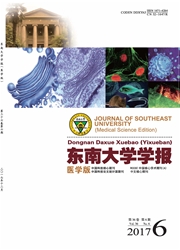

 中文摘要:
中文摘要:
目的:合成核壳结构的Fe3O4@Au多功能纳米材料,并对其形成机制进行探究。方法:通过"layer-by-layer法"和"种子生长法",合成了直径50-100 nm的铁核金壳的复合纳米颗粒,利用SEM、HRTEM、FTIR、XRD、SQUID等一系列手段测试表征其微观结构特征和磁学特性。最后利用数学模型进行计算,探讨这种纳米复合结构的形成机制。结果:合成得到了Fe3O4@Au颗粒,其机理可能是对pH敏感的聚合物保护剂(PEI,聚乙烯亚胺),由于其伸缩或者舒展的空间结构,导致Fe3O4-Au seed纳米颗粒聚集,并将金还原及生长于表面,最终形成Fe3O4@Au。结论:合成了核壳结构的Fe3O4@Au颗粒,这种具有核壳结构的多功能材料不仅可以应用于将来的磁性分离,而且还可以应用于生物分子的检测。
 英文摘要:
英文摘要:
Objective: To synthesize core/shell Fe3O4@Au nanoparticles as multifunction nano materials,and investigate the formation mechanism.Methods: We utilized the microwave oven syntheses the magnetic nanoparticles with diameter of 40 nm,which were used as core materials for the reduction of gold precursors,Fe3O4@Au nanoparticles with core-shell structure with diameter of 50~100 nm was then synthesized with layer-by-layer growth.The core-shell nanocomposites have been characterized using HRTEM,SEM,FTIR,XRD and SQUID techniques.The spherical core-shell model was introduced to investigate the formation mechanism.Results: We synthesized core/shell Fe3O4@Au nanoparticles.The possible mechanism was: pH-sensitive polymer(PEI),owing to a shrunken or stretched structure of PEI,leaded to the aggregation of the Fe3O4-Au seed nanoparticles,then gold reduces onto the surface of Fe3O4-Au seed nanoparticles.Conclusion: We synthesized core/shell Fe3O4@Au nanoparticles and this core/shell multifunction nano materials will not only have external magnetic separation by the core of Fe3O4,but also detect the large biological molecule using the shell of gold.
 同期刊论文项目
同期刊论文项目
 同项目期刊论文
同项目期刊论文
 High-Yield Fabrication of PLGA Non-Spherical Microarchitectures by Emulsion-Solvent Evaporation Meth
High-Yield Fabrication of PLGA Non-Spherical Microarchitectures by Emulsion-Solvent Evaporation Meth Preparation, Characterization and Osteoblastic Activity of Chitosan/Polycaprolactone/In Situ Hydroxy
Preparation, Characterization and Osteoblastic Activity of Chitosan/Polycaprolactone/In Situ Hydroxy Cytotoxic effects and the mechanism of three types of magnetic nanoparticles on human hepatoma BEL-7
Cytotoxic effects and the mechanism of three types of magnetic nanoparticles on human hepatoma BEL-7 Rational design and SERS properties of side-by-side, end-to-end and end-to-side assemblies of Au nan
Rational design and SERS properties of side-by-side, end-to-end and end-to-side assemblies of Au nan Biphasic calcium phosphate macroporous scaffolds derived from oyster shells for bone tissue engineer
Biphasic calcium phosphate macroporous scaffolds derived from oyster shells for bone tissue engineer Preparation and characterization of self-assembled nanoparticles of 6-O-cholesterol-modi?ed chitosan
Preparation and characterization of self-assembled nanoparticles of 6-O-cholesterol-modi?ed chitosan Fabrication of Cluster/shell Fe3O4/Au Nanoparticles and Application in Protein Detection via SERS Me
Fabrication of Cluster/shell Fe3O4/Au Nanoparticles and Application in Protein Detection via SERS Me 期刊信息
期刊信息
